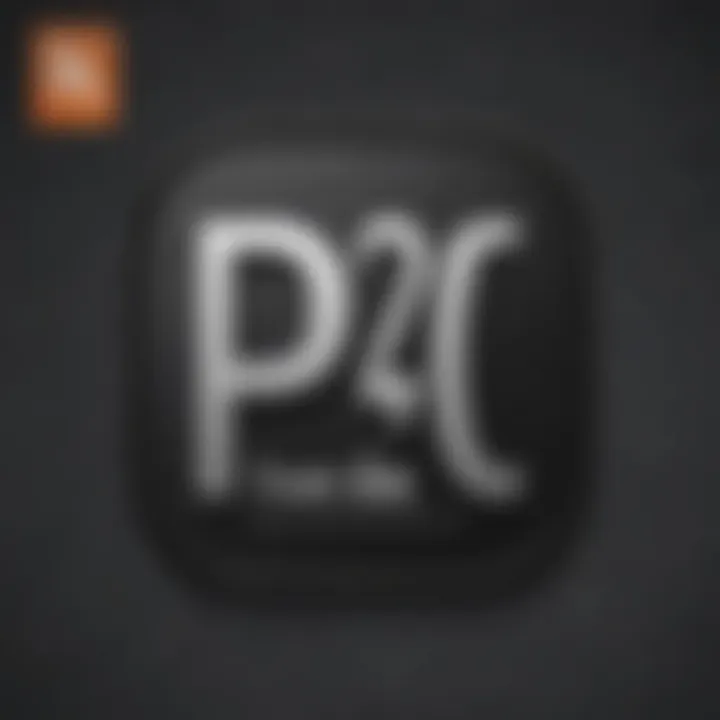Discovering Top Text Font Apps: A Detailed Guide


Intro
In the age of digital communication, typography remains a crucial component that shapes how we convey our thoughts and ideas. Text font applications have surfaced as essential tools for designers, writers, and everyday users aiming to enhance their textual expressions. From hobbyists to professionals, anyone who utilizes written communication can benefit from exploring the best text font apps available today.
This guide serves to dissect the notable features and functionalities of various font applications catering to diverse platforms and user needs. By including a variety of options tailored for distinct purposes, this article aims to navigate through the plethora of text font applications available and illuminate their significance in crafting visually impactful content.
As we embark on this explorative journey, we will examine key observations within the domain of text fonts, as well as their implications for personal and professional projects. Through this endeavor, we will uncover the evolving nature of font technology.
Overview of Text Font Applications
Latest Updates and News
Font technology evolves rapidly, reflecting trends and shifts in design preferences. Recent updates in popular font apps like Adobe Fonts, Google Fonts, and FontForge signify an increased emphasis on usability and integration with creative platforms. Newer functionalities include better search algorithms, more diverse typefaces, and improved accessibility features.
Trends and Popularity
Certain typography styles emerge as more favorable due to their unique aesthetics or recognition in the design community. For example, sans-serif fonts remain dominant in digital environments but are gradually seeing competition from modern serif and display fonts. Each trend influences how branding, advertising, and user documents are structured visually.
Lists of trending font categories often include:
- Minimalist and clean fonts for a professional appeal
- The resurgence of retro and vintage typefaces in designs
- Custom fonts that reflect company branding more directly
Releases and Announcements
Recently, various font apps have introduced new features. Adobe Fonts, known for its large library, frequently expands its collection. Another noteworthy mention is the addition of typeface customization options in apps like Canva. These continuous updates ensure designers possess a fresh toolkit for each new project.
In-Depth Analysis
Functional Features
Examining the capabilities of leading font files on applications allows users to find the most beneficial ones. Here’s what to look for when assessing text font applications:
- Interface Design: User-friendly engagement often governs overall satisfaction.
- Customization Options: Being able to adjust kerning, leading, and styles is a significant plus.
- Compatibility: Ensuring it works seamlessly with existing software or platforms reduces workflow interruptions.
Behind the Scenes
Development Insights
Understanding how these applications develop their infrastructure is as important as navigating their usability. Most applications pull cease on experts in UI/UX design, ensuring that the learning curve stays shallow for the end-users.
Reviews and Recommendations
Critic Reviews and Ratings
Font applications face assorted reviews in specialized forums. Generally favored tests denote specific offerings like quality of typeface web integrations and simplicity of purchasing or licensing fonts.
Tackling community input further enriches user knowledge; platforms like Reddit often showcase actual user feedback, bridging expectations with experienced users' insights.
Increasing familiarity with ultimately popular applications leads to a stronger grasp on how empowering yet versatile typography reflects in visual message structures.
In summary, the landscape of text font applications is rich and layered, providing an essential tool for enhanced communication in various contexts. Aiming for efficacy and professional adeptness is a worthwhile pursuit for typographers and designers aspiring to make profound aesthetic statements.
Intro to Text Font Apps
The realm of digital design requires more than just creativity; it demands an understanding of typography and the tools that optimize it. Text font applications serve as essential resources for anyone aiming to delve deeper into graphic design, branding, or personal creativity. By focusing on text font apps, this article highlights their significance, essential functionalities, and impacts. They harmoniously blend artistic expression with technical capability, supporting users in enhancing their projects.


The Importance of Typography in Design
Typography stands as a cornerstone in the world of design. Proper type usage contributes to clarity, conveys emotions, and even enhances brand identity. Choosing the right font can invoke feelings that otherwise might be missed. In commercial and personal projects, a carefully selected typeface can distinguish an idea from mediocrity.
- Readability: An appropriate font enhances the ease of reading.
- Aesthetics: Fonts contribute to a visual appeal, evoking specific moods or styles.
- Brand Identity: Typography is a defining element of logo and visual branding strategies.
With diverse font cultures and evolving trends, awareness of typographic subtleties can be greatly enriched through text font applications.
Overview of Text Font Applications
Text font applications enable users to access and manage a wide array of fonts. These tools equip both novice and professional designers with the capability to experiment with typography in varied contexts.
In recent years, the proliferation of such applications has heightened. They can be categorized based on their functionalities, usage scenarios, and platforms:
- Mobile Applications: Easy access to fonts on mobile devices.
- Desktop Software: Powerful tools that cater to professionals.
- Web Applications: Interactive platforms for online font manipulation.
The tools available today often integrate with design software and facilitate styles that may be widely recognized in films, TV shows, games, and comic books. Users looking to enhance their typographic choices find that appropriateness is not the sole consideration; functionality and experience further drive selections.
Criteria for Selecting Font Apps
When choosing a text font app, several criteria are crucial to ensure an optimal user experience. Each aspect directly contributes to the application's effectiveness, proving essential for users seeking precise typography choices in their work. The selection criteria discussed here include usability, variety, and device compatibility.
Usability and User Interface
The usability of a font app plays a substantial role in determining how effectively it serves its users. A clean, intuitive user interface is vital. Users should easily navigate through font styles without unnecessary complexity. To achieve that, font apps ought to integrate streamlined menus, visible search functions, and previews of selected fonts. Choices made in a fraction of a second can significantly affect design outcomes. Finding fonts quickly should be a seamless process.
Moreover, instructional prompts can be helpful for first-time users. User onboarding encourages exploration features without feeling overwhelmed. Therefore, apps that blend usability with an appealing design help users spend less time searching and more time creating.
Variety of Font Options
The availability of diverse font options is another critical factor. Users demand access to a wide range of styles, from classic serif fonts to modern sans-serif ones. Having the tools to choose lets designers target specific moods or themes media they working on.
In addition to unique styles, many font apps now support custom font uploads. This ability leads to distinct and signature aesthetics. Some revered apps include unique exclusives while also providing integration with open-source repositories. If users cross-reference among popular fonts or delve into niche categories, the flexibility ultimately enriches their design toolbox.
Compatibility with Devices
An often-overlooked criterion is compatibility. Users utilize different devices—be it smartphones, tablets, or desktop computers—and apps must be accessible across these platforms. Smooth functionality ensures that designers can execute projects while on the go or at their desks.
Real-time syncing between devices aligns to modern workflows. Many people cannot fford solution to work only off a single machine. Thus, expectations revolve around easy downloads, access potential for cross-platform capabilities without hinderance. Such adaptability promotes the usability further as it magically integrates into varied environments for focused creativity across diverse settings.
"The flexibility of font apps hinges greatly on their capacity to enhance creativity by meeting it where their users are."
Top Text Font Apps for Mobile Users
In today's increasingly mobile world, the relevance of text font apps cannot be overstated. Mobile users often rely on apps to personalize their device experience, enhance communication, and improve design aesthetics. Consequently, it is crucial to select a font app that meets these diverse needs effectively. Good font apps not only provide a variety of styles, but they also integrate seamlessly with mobile interfaces. Factors such as usability, customization features, and device compatibility determine the user's overall satisfaction.
In this era of personalization, users want to express their unique style through typography. The distribution of fonts across mini devices allows micro-expression of identity your text easily loses boldness with a formulaic font.
Popular Fonts and Their Features
When examining popular fonts, certain characteristics often define their widespread appeal. Fonts that offer versatility in style can benefit users significantly. Here, key genres tend to stand out:
- Serif Fonts: Bring tradition and formality.
- Sans Serif Fonts: These offer a modern, clean look, attracting a general audience.
- Script Fonts: Curvy and artistic, these styles convey personality.
Combining these styles in the right way can add depth to visual projects that otherwise may appear bland or generic. Available features in applications enhance your choice: text outline options, shadow customization, and alignment settings all enrich the font design.
Fonts App for iOS Devices


The landscape of text font apps for iOS devices is marked by several noteworthy participants. Apps such as Font Diner, WhatTheFont, and iFont make searching and applying fonts uncomplicated. With elegant interfaces and smooth performance, users engage fully without struggles. Each application grants extensive font selection across different genres; installation is straightforward, allowing users to incorporate products quickly.
Some of these apps also integrate with design software on iPads or iPhones. This accessibility becomes increasingly practical as many individuals create professional-level designs directly from mobile devices.
Fonts App for Android Devices
For Android users, options like FontFix, iFont, and Fonts for Instagram provide powerful bridges to expressive typography. The diversity of fonts is refreshing, as these apps often cater to subcultures focusing on novel designs that reflect unique tastes. Importantly, Android provides many free resources, granting creative freedom without the need for substantial investment.
A key feature includes the ability to install custom fonts directly through cloud storage or external apps. This function opens limitless opportunities for continuous personalization of text styles in messaging, branding, and content production.
By understanding and exploring the best text font apps for mobile use, a dynamic palette emerges for creativity, personal expression, and professional projects. The demand for captivating typography reflects the ongoing evolution of digital interaction, especially resonating with audiences interested in lifestyle evaluations across culture and design.
Best Font Apps for Desktop Users
In the realm of digital design, selecting the appropriate text font apps for desktop users holds significant importance. Professionals across various fields depend on quality typography to convey visually appealing messages. A robust font application enhances the design process, providing necessary tools for efficient font management and customization.
Font Management Software
Font management software allows designers to effectively organize their font libraries, aiding in swift and easy access when needed. These programs help prevent cluttered desktops and ensure that designers can rapidly find the right font for their projects. Popular options in this field include FontBase and Suitcase Fusion, both offering intuitive interfaces that cater to users’ needs. Features like tagging, and character previews streamline the workflow greatly.
Key functions of font management software include:
- Organizing: Easy sorting of fonts based on categories, styles, and favorites.
- Previewing: Quick visual previews of fonts and their variations.
- Installation and Uninstallation: Simplified methods to manage font installations dynamically without risking system performance.
These characteristics can directly contribute to a designer's efficiency and creativity. A well-managed font library allows for more time spent on design rather than searching for fonts.
Customization Options for Designers
Customization options provided by font apps present significant value for any design project. Designers work under varying requirements and frequently need unique typographic expressions to reflect their creative vision. Each font management software offers unique tools to allow for this customization.
For instance, applications like Glyphs and FontLab empower designers to create their own fonts. These tools allow for digitizing hand-drawn typography and include functionality for altering font weights, curves, and overall structure.
Considerations for customization might include:
- Character Alterations: Adjusting height, width and elements to create distinctive typography.
- Weight Adjustments: Modifying font weights can influence the mood and clarity of the text.
- Kerning Capabilities: Fine-tuning spacing between characters enhances readability and aesthetic appeal.
The ability to customize fonts translates directly into richer design experiences. When brand identity hinges on unique typography that captures attention, these customization options become not merely a tool, but a necessity.
Customization in typography amplifies creativity, fulfilling specific design demands seamlessly while providing unique graphic appeal.
Specialized Font Apps for Creative Projects
In the realm of design, specialized font apps cater to unique needs and preferences across different creative fields. These applications provide specific tools that enhance both creativity and productivity. They serve not only as repositories of diverse fonts but also as platforms for larger creative functionalities. Choosing the right app can define the effectiveness and appeal of graphic designs, print media, and web layouts. The importance of these specialized tools cannot be overstated.
Fonts for Graphic Design
Graphic designers require fonts that complement the visuals they create, imbuing projects with a unique identity and aesthetic. The best font apps here, like Adobe Fonts, offer vast libraries that simplify the research process. Many programs allow designers to preview typefaces against their designs. This feature supports real-time decisions, greatly facilitating stock selection during the design workflow.
Additionally, integrating fonts from these apps can streamline collaboration between designers. When accessing a common library, teams can maintain consistency across projects. It increases efficiency while minimizing issues that arise from mismatched typography choices.
Fonts for Desktop Publishing
Desktop publishing often demands specific typographic styles that enhance written content's legibility and visual appeal. Apps like QuarkXPress and Microsoft Publisher come equipped with diverse font styles catering to publications like magazines, brochures, and more. When designers care about the textual component as much as they care for visuals, appropriate font selection is crucial.
Consideration of readability at various sizes is highly relevant. Many desktop publishing software tools allow users to test how text looks in different contexts directly within the app, saving time and ensuring optimal presentation needs are met.
Fonts for Web Design


Web design imposes its own set of constraints when it comes to font selection. A specialized font app can offer specific solutions tailored for online platforms. Tools like Google Fonts not only showcase website-friendly typefaces but also offer variations that enhance site loading speeds, ensuring concise delivery. Typeface combinations can also be suggested, which is fundamental in web design, considering clear visual hierarchy and user experience is key.
Instant access to versatile fonts from specialized apps enriches creativity and improves workflow efficiency. Prioritize tools that meet your specific needs for optimal results.
Emerging Trends in Font Technology
Emerging trends in font technology reshape how designers and users approach typography in today’s digital landscape. The increasing variety and sophistication of font applications elevate our creative potential. Understanding these trends enables individuals to embrace new styles and functionalities in their projects, ensuring that their typography remains relevant and dynamic.
Variable Fonts and Their Applications
Variable fonts introduce a groundbreaking approach to font design. Unlike traditional fonts, which are constrained to single styles or weights, variable fonts consolidate multiple styles into one single font file. This provides we versatility and efficiency. Designers can easily manipulate the weight, width, and slant of the font, allowing for a customizable experience based on the nuanced demand of their projects.
Benefits of utilizing variable fonts include:
- File Size Savings: Instead of loading multiple font files for various styles, variable fonts significantly reduce loading time, ultimately contributing to better web performance.
- Design Flexibility: Designers have more creative options to work with. Rather than hunting for the specific style, they can easily adjust the parameters on-demand.
- Support for Customization: This feature is ideal for brands that wish to maintain a unique voice across platforms while expressing themselves dynamically.
In practical applications, variable fonts find their usage in web design, where responsiveness in design is critical. As screens vary in size, variable fonts adjust fluidly, making typography consistent across different viewports. This adaptability directly enhances user experience.
The Role of AI in Font Creation
AI technology is revolutionizing font creation. By utilizing machine learning algorithms, designers are rapidly exploring new horizons in type design. AI stands as an intelligent aide, enabling streamlined processes. Here are some noteworthy impacts of AI on the font landscape:
- Faster Design Processes: AI can automate certain repetitive tasks in font creation, providing designers more time for conception and conceptualization.
- Error Detection and Suggestions: With advanced algorithms, AI offers real-time feedback, identifying common inconsistencies and suggesting optimization remarked designs.
- Personalized Font Recommendations: AI-driven applications analyze user preferences and past selections. This intelligence is leveraged to offer font recommendations that align well with specific design contexts.
Furthermore, AI’s ability to synthesize design choices presents opportunities for non-designers. These emerging applications allow broader access to tailor fonts to personal needs. This democratizes font design, continuously expanding typographical diversity available in creative projects.
Emerging trends in font technology, such as variable fonts and AI involvement, provide exciting spaces for exploration in typography. Acknowledging this evolution helps to enhance design aesthetic and fulfills practical preferences.
User Reviews and Feedback on Font Apps
User reviews and feedback play a critical role in the evaluation of text font applications. These insights from users shed light on functionality, ease of use, and potential issues that may not be apparent from marketing materials. Understanding user sentiments can significantly enhance decision-making for potential users looking to install a font app.
Analyzing Feedback Trends
When analyzing user feedback, patterns often emerge that highlight the strengths and weaknesses of different text font apps.
- Ease of Use: Users often prioritize intuitive interfaces. Many express frustration when apps require excessive learning or complicated navigation. Positive feedbacks frequently mention how simple features allows for fast design choices.
- Performance: Key observations include how quickly fonts can be uploaded or applied. Users highlight apps that offer quick downloads and seamless integration into other apps while pointing out slow or clunky apps.
- Variety and Quality of Fonts: Comments usually reflect appreciation for unique and diverse font options. Users report dissatisfaction when apps do not frequently update or offer a wide variety. A rich selection is a common expectation in user reviews.
- Support and Updates: Regular app maintenance leads to better user satisfaction. Positive sentiment generally reflects appreciation when developers actively listen to feedback and resolve arising issues.
According to feedback collected from various forums like reddit.com, specific trends suggest that users also favor community contributions. User-generated content often brings new perspectives and eclectic font styles that may not be available through standard offerings.
Common User Recommendations
Based on the insights gathered from user reviews, here are some common recommendations from aficionados of typeface design:
- Prioritize Simple Interfaces: Opt for font apps like WhatTheFont or FontForge, often appreciated for their ease of navigation by both novices and experts alike.
- Seek Diverse Font Libraries: Many users recommend apps that not only offer classic fonts but also introduce contemporary and custom designs, such as Adobe Fonts and Google Fonts.
- Check Device Compatibility Beforehand: Feedback shows that universal accessibility across different devices is integral. Apps that work seamlessly on both iOS and Android, such as AnyFont, are preferred.
- Engage with Developer Support: Users often prefer those apps that actively communicate updates and troubleshoot feedback received from user queries. Great customer service enhances the overall experience.
The End: Choosing the Right Font App
Selecting the right font application is essential in expanding the range of creative options for personal or professional projects. Typography extensively influences the visual appeal and readability of content. A thoughtful choice streamlines the process of expressing ideas clearly and effectively. In this era of digital communication, the ability to distinguish an attractive typeface is key. It can lead to better engagement and heightened visual impact.
Features such as usability, variety of fonts, and compatibility with devices play significant roles when determining suitable font apps. It is necessary to evaluate individual needs like device preference, design purpose, and desired aesthetic. Some applications are more suited for specific tasks than others, so understanding a few indispensable traits lets users make informed choices.
Ultimately, font applications do more than add aesthetic value. They can embody brand identity and connect more meaningfully with audiences. As design continues to evolve in complexity, font apps provide users with resourceful tools to align their creative visions with reality.
Final Thoughts on Typography
Typography is central to communication in both print and digital formats. A well-chosen font not only conveys information but can capture emotions and moods. The perception of text is affected by typography and it greatly influences how messages are understood. Simplicity and legibility are often vital, but experimentation with styles can bring remarkable results.
Most importantly, recognizing the trends and shifts within typography helps creators remain relevant. Respected typographers often state that type choice is about understanding culture rather than simply picking a pretty font. By melding aesthetics with practicality, designers heighten experiences for their audiences.
Future Directions for Font Apps
The progression of font apps is set to continue as technology advances. With artificial intelligence being integrated, the landscape for font creation is changing. Automation will likely streamline tedious processes and allows designers to focus on artistic endeavors. Variable fonts are another major trend, providing users with a wide array of control through a singular font file.
These innovations lead to more dynamic designs and broaden accessibility for creators. Future font apps may also employ augmented reality to let users visualize fonts in diverse contexts, revolutionizing how font selections are made.
Ultimately, examining emerging technologies is crucial for visual artists aiming to leverage identification and differentiation in their work. Trends will continue crafting a fascinating interplay between artistry and technology.
Typography is more than just an art form; it's a fundamental way to communicate universally.



